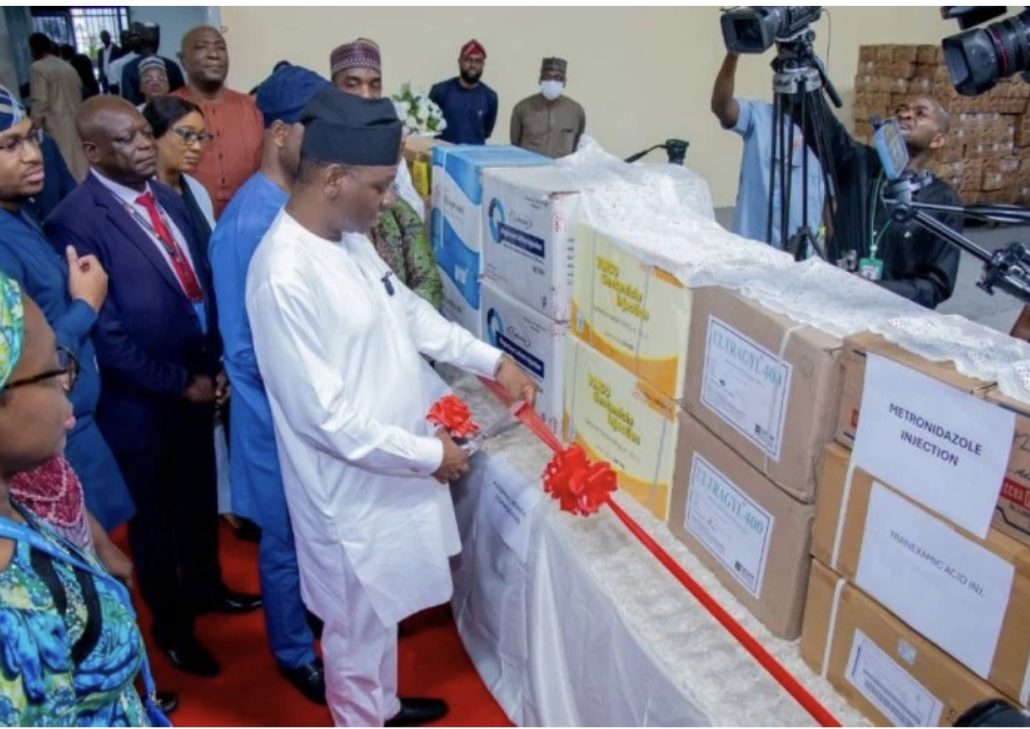
Photo caption: The Executive Director of the NPHCDA, Dr. Muyi Aina, officially flags off the distribution of essential maternal and child health commodities in Abuja on Tuesday. Photo: NPHCDA
…..10 states, 1,936 PHCs benefit in first phase
The Federal Government yesterday flagged off the nationwide distribution of essential maternal and child health commodities valued at N2.9 billion, in what officials described as a renewed push to stem Nigeria’s high rates of maternal and newborn deaths.
The exercise, coordinated by the National Primary Health Care Development Agency (NPHCDA) in collaboration with development partners, was launched in Abuja by the agency’s Executive Director, Dr. Muyi Aina.
The commodities—21 categories of lifesaving medicines and supplies—will first be deployed to 1,936 primary healthcare centres (PHCs) across 80 Local Government Areas (LGAs) in 10 states: Bauchi, Borno, Ebonyi, Kaduna, Kano, Katsina, Niger, Plateau, Yobe and Zamfara.
According to the United Nations Children’s Fund (UNICEF), Nigeria records a maternal mortality rate of 576 per 100,000 live births, the fourth highest in the world. Every year, about 262,000 babies die at birth, the second-highest figure globally. Infant mortality stands at 69 per 1,000 live births, while 128 per 1,000 children die before their fifth birthday—over half from malaria, pneumonia, or diarrhoea.
Dr. Aina described the initiative as a “critical intervention to save lives, close service delivery gaps, and give frontline health workers the tools they need to deliver quality care.”
“Too many women die needlessly from preventable causes. Our mothers and newborns deserve better,” Aina said.
He explained that the distribution is being carried out by zones to ensure equity and prioritisation of high-burden areas:
North West Zone: 940 PHCs in 44 LGAs
North East Zone: 756 PHCs in 29 LGAs
North Central Zone: 124 PHCs in 5 LGAs
South East Zone: 116 PHCs in 2 LGAs
Beyond supplies, the rollout includes training of health workers, provision of equipment, and infrastructure upgrades.
Aina, however, stressed that sustainability rests largely with states and local governments:
“The states have the primary responsibility for service delivery. This intervention shows the difference the Federal Government can make, but it is states that must take ownership and sustain it.”
He revealed that the government will begin annual tracking of maternal mortality to monitor progress and adjust strategies.
“If our strategy is working, we double down. If it’s not, we pivot. But what is not acceptable is business as usual,” he said.
On sustainability, he disclosed that agreements were secured with states before rollout.
“Part of the reason why it took us time to start was to get commitments from states that they would sustain the funding for these commodities,” he explained.
Representatives of development partners hailed the initiative.
Mary Brantwo of the World Health Organisation (WHO) described the commodities as “tools of hope, dignity and survival” and praised NPHCDA for ensuring supplies reach communities that need them most.
Achu Lordfred of the United Nations Population Fund (UNFPA) said the intervention aligns with UNFPA’s mission to prevent maternal deaths, promote family planning, and end gender-based violence.
He cited UNFPA’s support for heat-stable carbetocin, a drug proven to reduce maternal deaths, and expressed optimism that the new commodities would “accelerate progress in reducing maternal and newborn deaths in frontline facilities.”
Stakeholders at the event agreed the intervention represents a milestone, but warned that Nigeria’s challenge lies not only in investment, but in ensuring commodities reach women and children at the last mile.